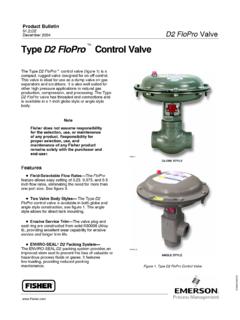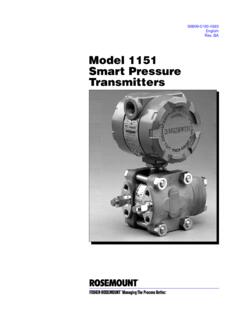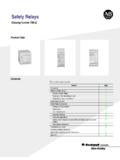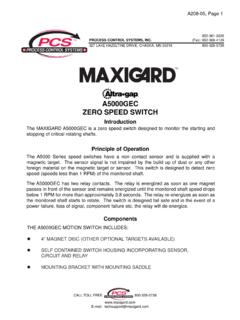Transcription of 800-2.0 Typical Wiring Diagrams for Push Button …
1 Product DataTYPICAL Wiring DIAGRAMSFor push Button Control StationsBULLETIN 800 SSTANDARD DUTYA-2750 BULLETIN 800 TOIL TIGHTB-130 BULLETIN 800 HHEAVY DUTYCORROSION-RESISTANTBOOTEDA-6178 BULLETIN 800 HHEAVY DUTYCORROSION-RESISTANTBOOTLESS89-068-gB ulletin 800 Control Stations are a rugged line ofdevices designed for use in control circuits Thesecontrol stations offer compact size and dependableoperation to meet most application control stations are available in avariety of combinations that can include pushbuttons, selector switches, pilot lights, and specialpurpose -June, 1989 Supersedes Publication Dated November, 19772 Typical Wiring DiagramsFor push Button Control StationsTable of ContentsGENERAL INFORMATION .. Page 2 push button CONTACT SELECTION .. Page 3 PILOT LIGHT SELECTION .. Page 4 UNDERVOLTAGE PROTECTION.
2 Page 4 UNDERVOLTAGE RELEASE .. Page 4 EXPLANATION OF SYMBOLS .. Page 5 START-STOP CONTROL Wiring DIAGRAMSS ingle Station - Basic Circuit .. Page 6 With Motor Running Pilot Light .. Page 6 With Motor Stopped Pilot Light .. Page 7 Group of Single Stations with Master Stop Button .. Page 7 Maintained Contact Buttons- Undervoltage Release .. Page 8 Multi-StationWith Momentary Contact push Buttons .. Page 8 REVERSING CONTROL Wiring DIAGRAMSR eversing Station - Basic Circuit .. Page 9 With Direction Indicating Pilot Lights .. Page 9 TWO-SPEED CONTROL Wiring DIAGRAMSTwo Speed Station - Basic Circuit .. Page 10 With Speed Indicating Pilot Lights .. Page 10 MISCELLANEOUS Wiring DIAGRAMSS eparate Start, Stop and Jog ButtonsWith Standard push Buttons and a Jog Relay.
3 Page 11 Thermostat Controlled MotorWith Selector Switch - Undervoltage Release .. Page 11 Ground DetectionWith push -to-Test Pilot Lights .. Page 12 General InfoINFORMrma Information This publication is designed to serve guide in understanding control handy reference pointing out the features of the morecommon guide in the selection and installation of push buttoncontrol Wiring DiagramsFor push Button Control Stations 3 Genera/ Information@Each circuit is illustrated with a control circuit(con tinued)schematic or line diagram and a control station schematic or line diagram includes all thecomponents of the control circuit and indicates theirfunction.*The control station Wiring diagram is a representation ofthe physical station, showing the relative positions ofunits, the suggested internal Wiring , and connectionswith the common to most circuits are explained on Page common symbols are explained where they The symbols used in this publication were adaptedNOTE - The symbols used in this publication were adaptedby Allen-Bradley for use in accordance with NEMAby Allen-Bradley for use in accordance with NEMA standards.
4 A particular application must satisfy the needsstandards. A particular application must satisfy the needsof the user and comply with applicable codes and laws beforeof the user and comply with applicable codes and laws beforeusing any of the Typical circuits shown in this any of the Typical circuits shown in this publication.,, push ButtonContact SelectionIn the United States, contacts are normally rated byNEMA (National Electrical Manufacturers Association)standards. Internationally, contacts are rated by IEC(International Electrotechnical Commission) standards. Bymatching the contact rating to the load requirements, aproper contact block can be selected. Typically, push Buttoncontact selection includes the following factors;Voltage/Amperage Requirements, Type of Load contacts selected must be capable of handling thevoltage and current to be switched.
5 Control circuit loads aretypically called pilot duty loads. The load being switchedcan be a relay, contactor, or similar device that activates a"power"power circuit . Pilot Duty devices should not be used toswitch horsepower or lighting loads unless they arespecifically rated to do state applications such as those with programmablecontrollers may require contacts that are able to switch lowcurrent and low voltage resistive loads. Logic reed typecontacts provide reliable switching of solid state loads withminimum contact or hazardous location environments mayrequire the use of sealed switch type contacts. Applicablecodes should always be Wiring Diagramsfor push Button Control StationsPilot Light SelectionPilot Light selection is based on the following factors;Voltage, Lamp Requirements, Environment, and voltage of a pilot light must match the voltage both AC and DC voltage sources are available, AC voltageis recommended because it typically extends lamp life onincandescent units.
6 When using an AC source of 120 Voltsor higher, a transformer type pilot light can also increaselamp of the type of lamp can also affect lamp life. Thereare three types of lamps commonly used in pilot lights;incandescent, neon, and LED (Light Emitting Diode).Incandescent lamps have the shortest lamp life and aresusceptible to damage from shock and lamps with lower voltages have thickerfilaments and burn cooler, plus are more durable. Neonlamps provide longer lamp life, but have slightly reducedillumination. LED lamps provide the longest lamp life andare the least susceptible to damage from shock requirements are also important whenselecting a lamp. Depending on the color, an incandescelamp can provide brighter illumination when comparedwith a neon or LED of the unit in terms of initial expense should also be4addressed.
7 Although it may be cost effective to initiallyinstall a device with a full voltage incandescent lamp, atransformer type, LED or neon unit can reduce downtimecosts through increased lamp more information on Pilot Light selection, refer toAllen-Bradley, Milwaukee, otherwise specified, the circuits provideProtectionundervoltage protection or "three wire control. In theevent of power failure, these circuits are designed to protectagainst automatic restarting when the power returns. Thistype of protection should be used where accidents or damagemight result from unexpected circuits using undervoltage release or "two wire Releasecontrol are noted in the Table of Contents. With any type ofcontrol, the motor starts automatically after a power , these circuits involve automatic pilot devicessuch as thermostats, float switches, Wiring DiagramsFor push Button Control Stations5 Explanation ofSymbolsMomentary Contact push Button -Auxiliary Contacts-Operate whenOperating Coil of Contactor:Depressing Button opens andparent switch does.
8 In this case,M - Main Line S - Slowcloses lower contacts. Releasing normally open ( ) contacts close F - ForwardF - Fastbutton returns contacts to theand normally closed (NC.) contactsR - ReverseCR-Control Relaynormal condition when coil (M) is \I0 I0\0\J0J0 Overload Relay Contacts -a0\J0(One or more depending0on starter construction)./000.\J0\J00))\0#)ILl1, I/sTtP-,2 START-t3 fI,/ CONTROL CIRCUIT/ push Button CIRCUITWIRING DIAGRAM0-04 Reference Point-Identified onstarter, corresponds withnumber shown in push buttonstation Wiring of Conductors -Absence of node indicates wirescross with no Line - Symbolized byweighted Wiring DiagramsFor push Button Control StationsStart-Stop ControlWiring DiagramsSINGLE STATION -BASIC CIRCUITr---------1kla,I!IzlIIIIIIIIfo 0; the START Button energizes coil M, hold-incontacts M and maintains the circuit after the START Button is the STOP Button breaks the circuit, de-energizing coil M,contacts M return to their normally open PROTECTION -Operation of the overload relay contactsbreaks the circuit, thus opens M.
9 To restart the motor, the overloadsmust be reset and the START Button must again be Button STATIONSIType of StationICatalog NumberrStandard DutyI-- ~800S-2 SAIUNDERVOLTACE PROTECTION - If a power failure de-energizes thecircuit, hold-in contacts open. This protects against the motor startingautomatically after the power returns. Unless otherwise stated, circuitsto follow incorporate Undervoltage Duty- BootlessCorrosion-ResistantI800H2HA4 RLI1 Oiltight/Watertight800T-2 TAISINGLE STATION -WITH MOTOR RUNNING PILOT LIGHTr--w-----v1 PILOT LIGHTSTARTSTOP 1 STARTa. 2 0M4) LIGHT231 IIL---------JWhenever the motor is running, the pilot light is illuminated. Except for this modification, the circuit and its operation is thesame as the basic single Button STATIONSIIIIType of StationIVoltageStandard DutyHeavy DutyGeneral PurposeHeavy Duty - BootedHeavy Duty - BootlessOiltight/Corrosion-ResistantCorr osion-ResistantWatertightCatalog NumberCatalog Number120V240V480V, 60Hz600V, 60Hz800S=2 SAP800S-2 SAP800H-2 HAR800H-2 HAP800H-2 HAY800H-2 HAV800H-2 HAR4R800H-2 HAP2R800H-2 HAY4R800H-2 HAV4R800H-2 HAR4RL800H-2 HAP4RL800H-2 HAY4RL800H-2 HAV4RL800T-2 TAR800T-2 TAP800T-2 TAY800T-2 TAVT ypical Wiring DiagramsFor push Button Control Stations7 Start-Stop ControlWiring DiagramsSINGLE STATION -WITH MOTOR STOPPED PILOT LIGHTL1 STARTL2-_I1 STOP2 OI 3 n Aux.
10 T\ LIGHTL2423 PILOTLIGHTSTARTSTOPB ulletin 1495 normally closed auxiliary contacts are required. With the motor running contacts are open; with the motor stoppedcontacts are closed and the pilot light is illuminated. The basic circuit and its operation is the same as the diagram on Page Button STATIONSIV oltage120V240v480V 60Hz600V 60 HzType of StationStandard DutyCatalog Number800S-2 SAP800S-2 SAPH eavy DutyGeneral PurposeCatalog Number800H-2 HAR800H-2 HAP800H-2 HAY800H-2 HAVH eavy Duty - BootedHeavy Duty - BootlessOiltight/Corrosion-ResistantCorr osion-ResistantWatertightCatalog NumberCatalog NumberCatalog Number800H-2 HAR4R800H-2 HAR4RL800T-2 TAR800H-2 HAP4R800H-2 HAP4RL800T-2 TAP800H-2 HAY4R800H-2 HAY4RL800T-2 TAY800H-2 HAV4R800H-2 HAV4RL800T-2 TAVGROUP OF SINGLE STATIONS-WITH MASTER STOP I-Ml0 00 0-O-G --O ykMlI; 01 STARTL --------- 0M2II\ STOPIO 0;12 i.












